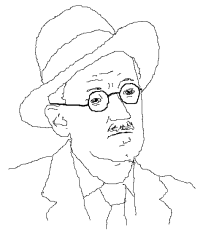 I’ve been reading David Lodge’s ‘Consciousness and the Novel’. Lodge points out that novelists share with cognitive scientists the aim of exploring human consciousness, but have characteristically different methods and concerns; typically concentrating on the idiosyncratic, qualia-ridden details of individual experience rather than seeking to extract generalisable scientific laws.
I’ve been reading David Lodge’s ‘Consciousness and the Novel’. Lodge points out that novelists share with cognitive scientists the aim of exploring human consciousness, but have characteristically different methods and concerns; typically concentrating on the idiosyncratic, qualia-ridden details of individual experience rather than seeking to extract generalisable scientific laws.
Lodge is good at technical analysis of the means by which novelists obtain their effects (I’m surprised he manages to write readable fiction while carrying such a weighty theoretical apparatus in his head – I should have thought it would induce a paralysing self-consciousness). In the first chapter he presents the development of narrative styles as being in part a search for more effective ways of conveying the reality of human conscious experience. In particular, he interprets modernist and stream-of-consciousness novels as attempting to break through the stale conventions of the traditional novel and give an altogether more immediate impression of consciousness from the inside. James Joyce is in his eyes the most radical and successful of the authors to make this attempt – in fact
‘He came as close to representing the phenomenon of consciousness as perhaps any writer has ever done in the history of literature.’
Well, up to a point. I think the Joycean style (as exemplified in Ulysses) is simply based on a new and different literary convention which is in reality at least as far from ordinary consciousness as the prose of Jane Austen. That explains why Joyce is, frankly, hard going at times and remains the preserve of the intellectual reader. If it were a vivid unmediated gateway into the phenomenal experience of the characters, Joycean prose would be the easiest to write and read and he would surely be among the most popular and accessible of authors.
This sort of paradoxical development – the attempt at nature which produces new artifice – is far from unique in Eng Lit, of course: it’s hard for modern readers to believe that the Lyrical Ballads, for example, could be presented as a breakthrough in the use of everyday language shorn of poetic affectation, yet start with something as peculiar as The Rime of the Ancient Mariner. But consideration of what Joyce does and does not achieve is interesting so far as the nature of conscious experience is concerned.
What are in fact the contents of consciousness? Drawing on introspection I find that some of them are indeed properly formed verbal sentences: as I sit here writing, fragments of text are replayed through my mind, adjusted and echoed immediately before being typed. Explicit words feature in my consciousness on other occasions too, but these occasions seem to me the exceptions and full-blown English sentences are certainly not the chief medium of my conscious experience.
That chief medium seems to be composed of thoughts which are as clearly focussed and meaningful as pieces of text, but have none of the same structure. I may think that a noise outside is probably the postman: to think so takes no appreciable time and does not involve the rehearsal of a formula over one or two seconds, as verbal thought might do. At the same time, I can go on thinking the same thought for a while if I choose, and when I think something else the transition may be abrupt, but is often smooth and unclear.
This is partly because, beside the mainstream thoughts there are a number of other candidate thoughts lurking in the penumbra of consciousness. I may be thinking about what I’m writing, but I’m sort of aware that I might think about whether it’s time to leave quite soon. A transition between one thought and another may therefore be a matter of one coming forward and another receding – though it can be the sudden intrusion of an altogether new thought, too. Although this penumbra business is undoubtedly vague, I think it is always clear that only one thought is actually being thought at any given time.
At the risk of schematising too much, we could say that the mainstream of thought is accompanied by an intermittent superstructure of explicit verbal thoughts and often by a hazy underground of potential thoughts. But the mainstream itself is fluent and non-verbal, though just as meaningful as words. All my thoughts, moreover, come with a kind of background. When I think that a sound outside might be the postman, I do not have to think about the history of the Post Office, my uncle who once worked for it, or the items of post I am expecting some time soon; but all those items are somehow readily available; not in quite the same way as the candidate thoughts I mentioned above – they’re not sort of wanting to be thought about, they’re just available.
Besides this, there is a general awareness of the world around me. Sometimes this recedes into a penumbra like the one in which the candidate thoughts lurk – I’m not quite sure whether it is in fact the same penumbra, nor whether the spotlight of attention is the same for thoughts and perceptions. I rather think I can pay attention to a perception and a thought at the same time, but it may be that they have to jostle for essentially the same attention, and at best merely alternate at the forefront of my mind. I’m not quite sure.
The objects I do perceive all come with a ready-made interpretation. When I look at the screen, I see the text of a blog post, but if I wish I can change the interpretation and see characters in a particular font, arrays of pixels, or my computer. Again, I don’t quite know whether these interpretations are the same kind of thing as the background awareness that comes with my thoughts. There seems to be a similarity, but the interpretations are required in a way that the background isn’t. I can’t look at the screen without giving it some interpretation, but I can think about the postman while ignoring all the associations that he brings with him.
A special case of my awareness of the world is my awareness of my own body, which I think exceptionally does not require interpretation (there’s only one thing a pain in my foot can be), but which is closely associated with my awareness of my own emotions. Emotions may be linked with a racing heart or a tightness in the stomach, but they are also linked with the most complex and sophisticated of my thoughts. I have a general emotional background (fairly calm at the moment, but tinged with some slight tension about when I need to leave the house, and the prospect of seeing the dentist later), and I also have emotional reactions to particular perceptions and thoughts.
I have certainly omitted and misrepresented a good deal in the foregoing, but I hope this sketch of the contents of consciousness is recognisable enough.
Novelists of any school clearly face some severe problems. One is the inherent indescribability of the qualia which make up or accompany our perceptions, and of the inner nature of emotions. Two others appear equally insoluble. One is how to represent thoughts which are meaningful, but not verbal in form. One way is to translate the thoughts into words, and present them as if they were like utterances of the character in question: but this short-changes us on the fluid and instantaneous nature of thought, and breaks the link with the background; it also destroys the difference between mainstream thoughts and thoughts in actual words. The alternative is to describe the content of the thought, but this loses the sense of vivid intentionality which thoughts have and condemns us to a third-person view, outside the consciousness being depicted.
The other insoluble problem is how to present the simultaneous complexity of consciousness when the structure of prose obliges us to relate one thing at a time in sequence.
Traditional novelists use a mixture of translation and description to depict a character’s thoughts, adjusting the balance to suit their own purposes. Lodge says the ultimate development in this direction is free indirect style, in which the thoughts are translated into words but not presented as quotation. He regards Jane Austen as supreme in the use of this style; it is a particularly flexible and fluid approach which helps the author get the best of both translation and description while remaining lively and vivid.
I believe the second problem is mainly addressed in traditional novels by the use of carefully chosen implication, and by the even more powerful tool of implicature, where something omitted or added from the account indicates to the reader a large amount of subsidiary information which is not explicitly given in the text. This approach allows the author. to some extent at least, to evoke some of the background to the character’s thoughts and also to indicate more than one level of consciousness at once.
However, although these strategies work quite well in traditional novels, there is a degree of artifice about them which may detract from the reality of the portrayal, and distance the reader from the consciousness of the character. How much better, then, to simply transcribe the stream of consciousness as it actually occurs in all its confusing heterogeneity? The trouble is that the two problems touched on above are still there. What Joyce tends to give us, in the famous last chapter of Ulysses, for example, is a straight translation of the mainstream of thoughts. Sentences and other grammatical structures are ignored or broken down to help indicate the rapidity and fluidity of the mainstream, but in essence we only get one level of consciousness. Since the author has undertaken to give us everything at that level he can no longer build in helpful implicatures by adding or leaving out carefully chosen items: the reader has to cope with the whole flood of thoughts, and is forced to do more work than normal to try to infer the background. An unexpected side effect is that not much emotional tone comes through: the words seem rather like the affectless, breathless drone of someone in a trance or in a state of delirium. Joyce succeeds in making it readable by actually practising some covert selection of items and moderating the grasshopper leaps and repetitions which I think would occur in a more rigidly realistic transcription of mainstream consciousness.
Does it work, on the whole? I don’t think it delivers what was promised. In 1922 Joyce said:
“In Ulysses I have recorded, simultaneously, what a man says, sees, thinks and what such seeing, thinking, saying does to what you Freudians call the unconscious…”
which I think pretty much amounts to a claim to have delivered all the contents of consciousness sketched out above. I don’t think Joyce really did this, or if he did, it was by the crafty use of traditional novelistic skills within a modernist presentation. But that doesn’t mean Ulysses isn’t interesting and a considerable achievement.
I think the right way to see it is in the context of a general resort to unconventional means in the arts which took place in the nineteenth and twentieth centuries. By the middle of the nineteenth century or thereabouts, the technical problems of painting, music and writing had pretty much been solved to the extent that they ever could be, and optimum conventions and methods had been established. Our culture being what it is, it was impossible for creative people to sit back and spend a few centuries exploiting these achievements: they had to press on and deliver something new. Since there were no more problems to solve, this novelty had to come from approaches that were radically different rather than improvements on what had gone before: various forms of unrealism and abstraction, twelve-tone or atonal music – and the stream of consciousness in the novel. These novel approaches tended not to lead on to anything – Joyce has no real successors – nor to achieve great popularity, but they did at least open up new imaginative and creative possibilities.
So far as consciousness is concerned, we can perhaps see Joyce’s work as a bold attempt to offer an analysis of consciousness as a single, transcribable phenomenon: in my eyes it proves the opposite: that consciousness is inherently complex and no single simple theory can capture the whole thing.
 The idea that quantum mechanics is part of the explanation of consciousness, in one way or another, is supported by more than one school of thought, some of which have been covered here in the past. Recently MLU was quick to pick up on a new development in the shape of a paper by Efstratios Manousakis which claims that testable predictions based on the application of quantum theory have been borne out by experiment.
The idea that quantum mechanics is part of the explanation of consciousness, in one way or another, is supported by more than one school of thought, some of which have been covered here in the past. Recently MLU was quick to pick up on a new development in the shape of a paper by Efstratios Manousakis which claims that testable predictions based on the application of quantum theory have been borne out by experiment.
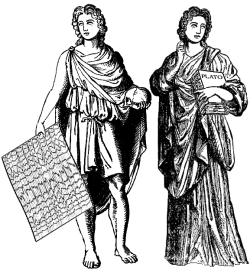 I’ve just caught up a bit belatedly with
I’ve just caught up a bit belatedly with 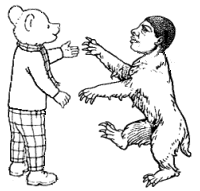 I came across A defense of Anthropomorphism: comparing Coetzee and Gowdy by Onno Oerlemans the other day. The main drift of the paper is literary: it compares the realistic approach to dog sentiment in J.M.Coetzee’s Disgrace with the strongly anthropomorphic elephants in Barbara Gowdy’s The White Bone. But it begins with a wide-ranging survey of anthropomorphism, the attribution of human-like qualities to entities that don’t actually have them. It mentions that the origin of the term has to do with representing God as human (a downgrade, unlike other cases of anthropomorphism), notes Darwin’s willingness to attribute similar emotions to humans and animals, and summarises Derrida’s essay The Animal That Therefore I Am (More To Follow). The Derrida piece discusses the embarrassment a human being may feel about being naked in front of a pet cat (I didn’t know that the popular Ceiling Cat internet meme had such serious intellectual roots) and concludes that taking the consciousness of animals as seriously as our own threatens one of the fundamental distinctions installed in the foundations of our conception of the world.
I came across A defense of Anthropomorphism: comparing Coetzee and Gowdy by Onno Oerlemans the other day. The main drift of the paper is literary: it compares the realistic approach to dog sentiment in J.M.Coetzee’s Disgrace with the strongly anthropomorphic elephants in Barbara Gowdy’s The White Bone. But it begins with a wide-ranging survey of anthropomorphism, the attribution of human-like qualities to entities that don’t actually have them. It mentions that the origin of the term has to do with representing God as human (a downgrade, unlike other cases of anthropomorphism), notes Darwin’s willingness to attribute similar emotions to humans and animals, and summarises Derrida’s essay The Animal That Therefore I Am (More To Follow). The Derrida piece discusses the embarrassment a human being may feel about being naked in front of a pet cat (I didn’t know that the popular Ceiling Cat internet meme had such serious intellectual roots) and concludes that taking the consciousness of animals as seriously as our own threatens one of the fundamental distinctions installed in the foundations of our conception of the world.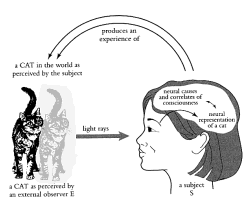

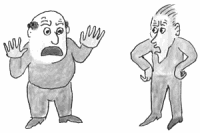 Steve Lehar, who has carried on a long dialectic with Max Velmans, kindly wrote to express sympathy for some of the points above. There is a charming exposition of his views in cartoon form
Steve Lehar, who has carried on a long dialectic with Max Velmans, kindly wrote to express sympathy for some of the points above. There is a charming exposition of his views in cartoon form  I’ve been reading David Lodge’s ‘Consciousness and the Novel’. Lodge points out that novelists share with cognitive scientists the aim of exploring human consciousness, but have characteristically different methods and concerns; typically concentrating on the idiosyncratic, qualia-ridden details of individual experience rather than seeking to extract generalisable scientific laws.
I’ve been reading David Lodge’s ‘Consciousness and the Novel’. Lodge points out that novelists share with cognitive scientists the aim of exploring human consciousness, but have characteristically different methods and concerns; typically concentrating on the idiosyncratic, qualia-ridden details of individual experience rather than seeking to extract generalisable scientific laws.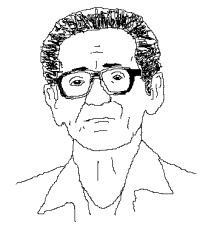 I’ve just heard that Benjamin Libet died at the end of July.
I’ve just heard that Benjamin Libet died at the end of July. Mirror neurons have been widely described as a crucial discovery and possibly ‘the next big thing’ (I’m not sure, when I come to think about it, what the last big thing was).
Mirror neurons have been widely described as a crucial discovery and possibly ‘the next big thing’ (I’m not sure, when I come to think about it, what the last big thing was). 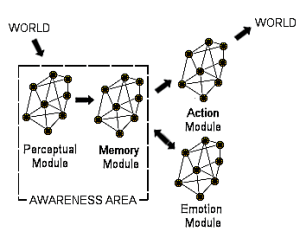
 I’ve been meaning to mention the paper in Issue 7 of the current volume of the JCS which had about the most exciting abstract that I remember seeing. The paper is “Why Axiomatic Models of Being Conscious?” . Abstracts of academic papers don’t tend to be all that thrillingly written, but this one, by Igor Aleksander and Helen Morton, proposes to break consciousness down into five components and offers a ‘kernel architecture’ to put them back together again. It offers ‘an appropriate way of doing science on a first-person phenomenon.
I’ve been meaning to mention the paper in Issue 7 of the current volume of the JCS which had about the most exciting abstract that I remember seeing. The paper is “Why Axiomatic Models of Being Conscious?” . Abstracts of academic papers don’t tend to be all that thrillingly written, but this one, by Igor Aleksander and Helen Morton, proposes to break consciousness down into five components and offers a ‘kernel architecture’ to put them back together again. It offers ‘an appropriate way of doing science on a first-person phenomenon. Yes, my eyebrows practically flew off the top of my forehead at some of the implied claims in that abstract. But not altogether in a good way. Perhaps we really are in the same realm of myth and confusion as the philosopher’s stone. Any excitement was undercut by the certainty that the paper would prove to have missed the point or otherwise failed to deliver; we’ve been here so many times before. Moreover, you know, even those axioms are not exactly a new discovery – Aleksander, with a different collaborator, first floated them in 2003.
Yes, my eyebrows practically flew off the top of my forehead at some of the implied claims in that abstract. But not altogether in a good way. Perhaps we really are in the same realm of myth and confusion as the philosopher’s stone. Any excitement was undercut by the certainty that the paper would prove to have missed the point or otherwise failed to deliver; we’ve been here so many times before. Moreover, you know, even those axioms are not exactly a new discovery – Aleksander, with a different collaborator, first floated them in 2003.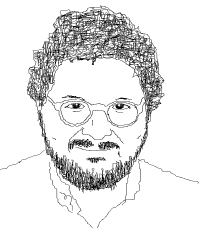 David Gelernter
David Gelernter